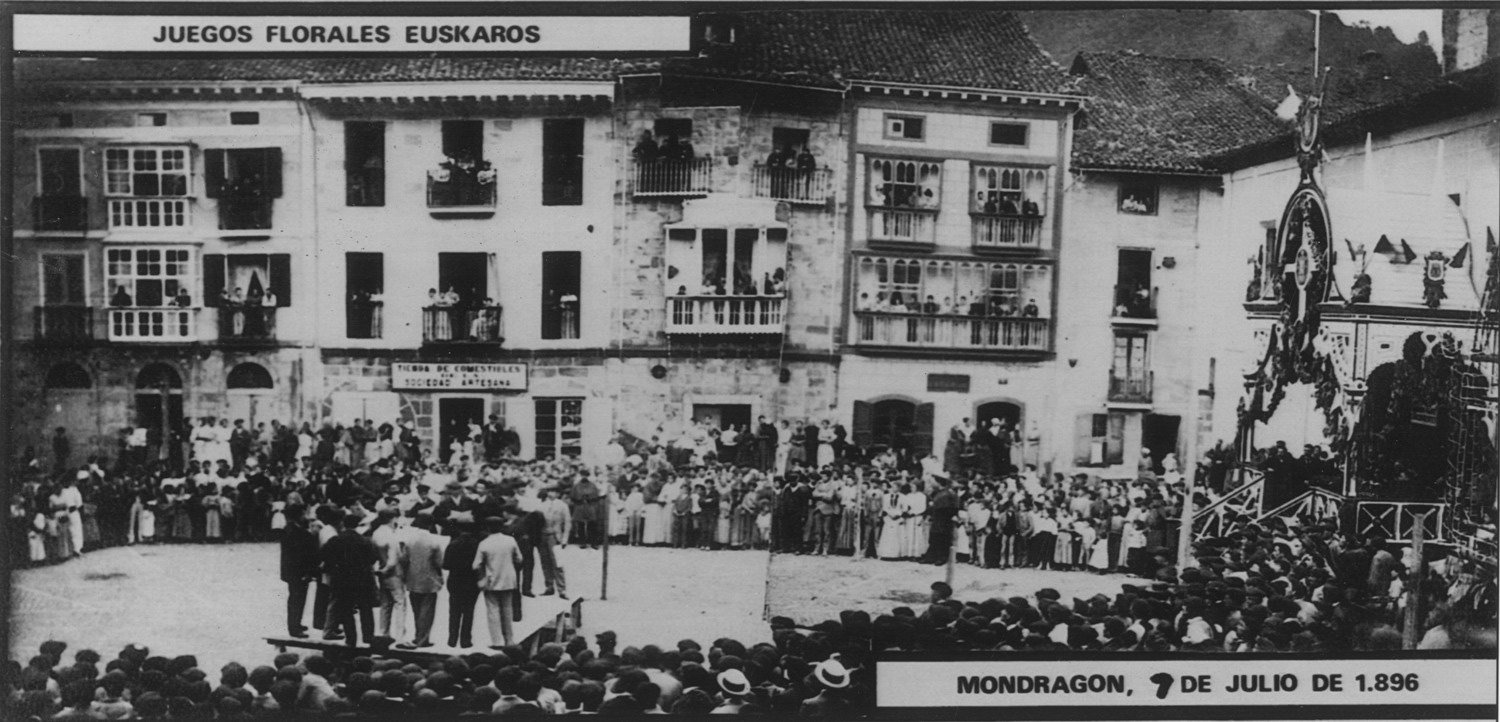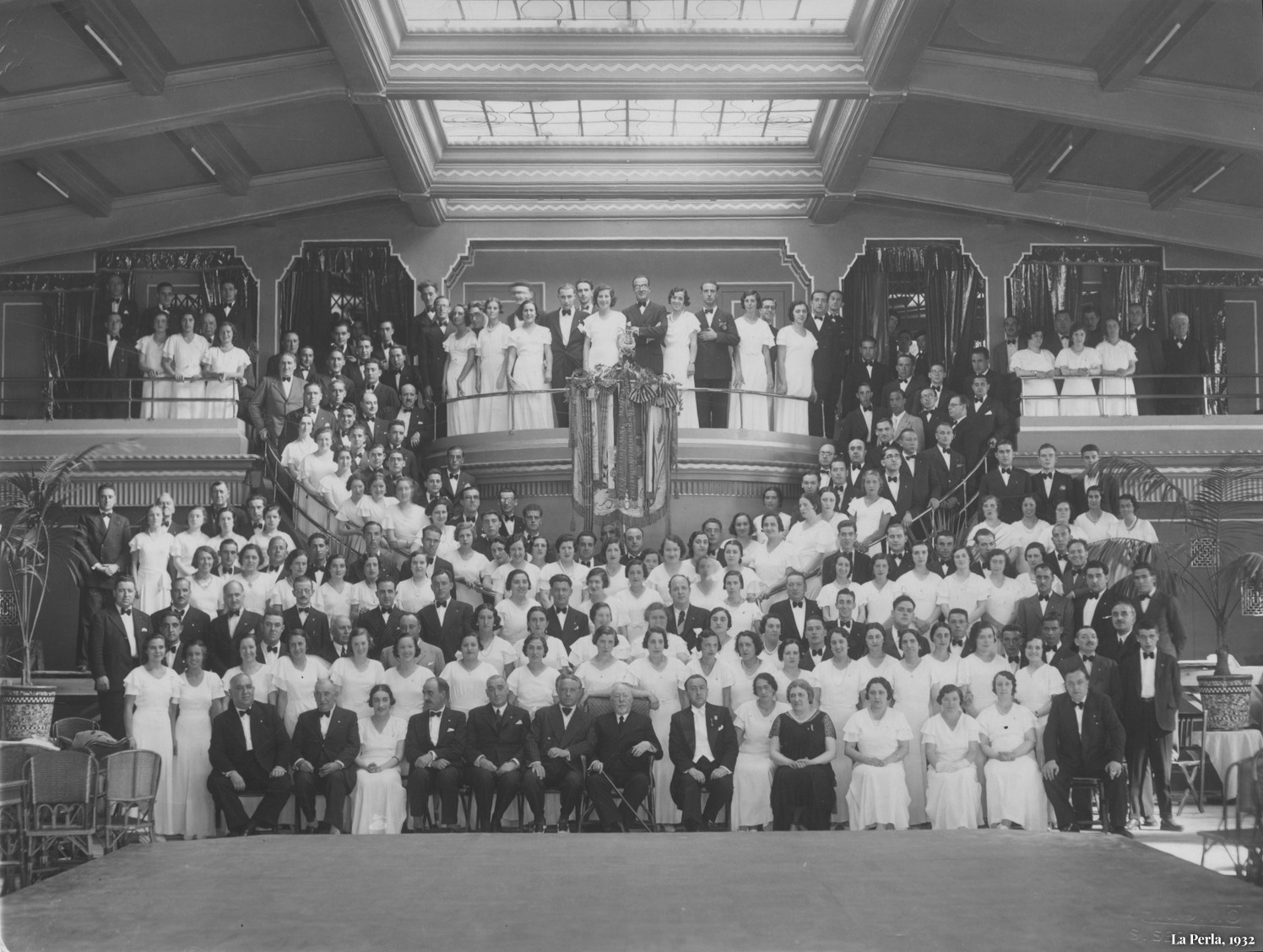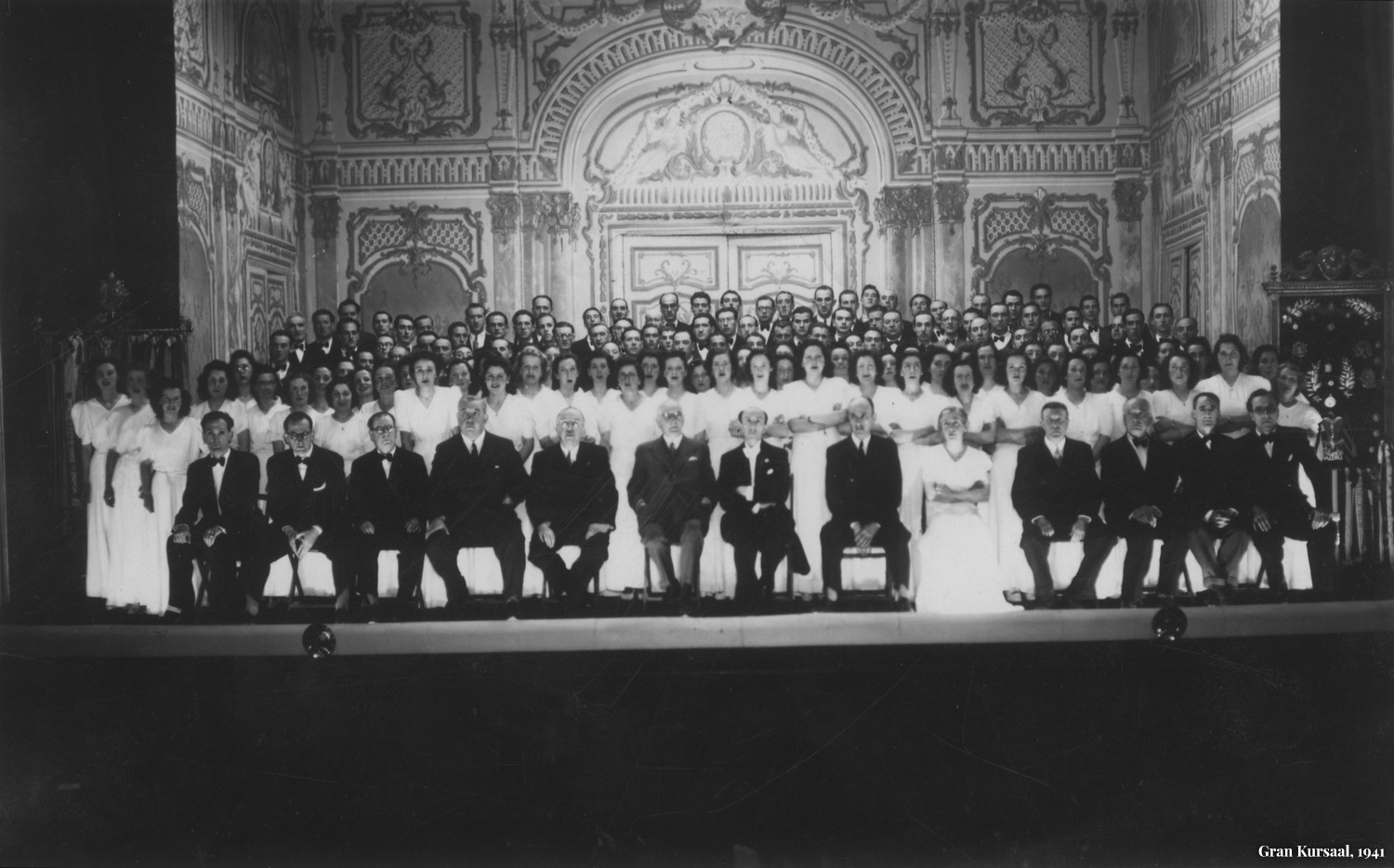Founded in 1897, the Orfeón Donostiarra combines its long history with the prestige of being considered the most important choir in Spain. Its repertoire covers one hundred symphonic-choral pieces, more than fifty operas and zarzuelas and many folk and polyphonic pieces. José Antonio Sainz Alfaro has been its director since 1987, and was preceded by Secundino Esnaola, Juan Gorostidi and Antxon Ayestarán.
Despite preserving its initial amateur spirit, the Orfeón works with a professional dedication, with an average of 35 to 40 concerts per year. It regularly participates in Spain’s most important music festivals. It has been a regular feature of the Musical Fortnight in San Sebastian, which in 1997 awarded the Orfeón its Gold Medal, and has only been absent on eight occasions since the event was first held. That same year the Granada Festival awarded the Orfeón its medal for “artistic and professional relevance and for its long-standing ties” to this event. To date it has performed in 33 editions of the Santander Festival. It has also regularly participated in the festival of the Canary Islands, in which it closed the 2007 and 2008 editions under the direction of Rattle and Muti, respectively, and also in the Peralada and Cuenca festivals.
The European festivals to which it has been invited include the Salzburg Festival, the Rhine Festival, the Ruhrtriennale, the Lucerne Festival, the Saint-Denis festival in Paris, the Chorégies festival in the French city of Orange and those of Radio France and Montpellier. In 2017 it is also taking part in the Proms in London.

Highlights from the international performances in recent years include those of the Philharmonie de Paris (2015), the Salle Pleyel in Paris and those of the Halle aux Grains in Toulouse, with the Orchestre National du Capitole de Toulouse and under the direction of Tugan Sokhiev. In 2013 it made its debut in Milan with the Symphony Orchestra of Milan Giuseppe Verdi and directed by Ricardo Chailly. In 2009, it sang for the first time at the Alte Oper in Frankfurt with conductor Paavo Järvi and the Hr Sinfonieorchester of Frankfurt. Two years earlier, in 2007, it offered a concert in the Golden Hall of the Musikverein in Vienna with the Vienna Symphony. In 2006 it travelled to Caracas (Venezuela) where it performed Symphony No. 9 by Beethoven, under the direction of Claudio Abbado, and the National Youth Symphony of Venezuela. It also started a collaboration with the West Eastern Divan Orchestra. In 2004, the tour in Holland with The Hague Philharmonic directed by Barenboim became the first three concerts of the international tour by the orchestra in 2006 and another in 2009. The Orfeón also participated in the hundredth anniversary celebrations of the death of Verdi with the Requiem by the Italian composer (2001) and with Barenboim and the Berlin Philharmonic with the Mass in F Minor by Bruckner (2001). In 1997, it sang in Berlin with the Philharmonic of the German capital and with the direction of Claudio Abbado at the Silvesterkonzert.
Orchestras, conductors and soloists
Outstanding among the orchestras it has collaborated with are the Berliner Philharmoniker, Czech Philharmonic Orchestra, Dresdner Philharmonie, English Chamber Orchestra, Hamburguer Symphoniker, Israel Philharmonic, Istanbul Symphonic Orchestra, London Symphonic Orchestra, Los Angeles Philharmonic Orchestra, Lucerne Festival Orchestra, New York Philharmonic Orchestra, Orchestra Filarmónica della Scala, Orchestre National du Capitole de Toulouse, Teatro San Carlos orchestra in Lisbon, Sinfónica de Galicia, Radio Symphonieorchester Wien, National Spanish Orchestra, Madrid Symphony Orchestra, Tenerife Symphony Orchestra, National Youth Symphony of Venezuela, RTVE Symphony Orchestra, Mariinsky Theatre Symphony Orchestra, Radio-Sinfonie-Orchester Frankfurt, Royal Symphony Orchestra of Seville, Rundfunk-Sinfonieorchester Berlin, Russian National Orchestra, Sofia National Opera Orchestra, The Royal Philharmonic Orchestra of London and the West-Eastern Divan Orchestra. The Orfeón has a special relationship with the Basque Symphony Orchestra, with which it performs several concerts every year.
Outstanding among the long list of conductors who have directed the choir are Abbado, Argenta, Barenboim, Chailly, Frühbeck, Gergiev, López Cobos, Maag, Makerras, Maazel, Markevich, Masur, Mehta, Muti, Nézet-Séguin, Ozawa, Pletnev, Rattle, Salonen, Saraste, Sokhiev, Stokowsky, Temirkanov, Ticciati, Víctor Pablo Pérez and Zedda.

It has also worked with many soloists, including outstanding performers such as De los Angeles, Armstrong, Baker, Bastianini, Berganza, Bumbry, Burrows, Caballé, Carreras, Van Dam, Donath, Domingo, Gigli, Janowitch, Lorengar, Marshall, del Mónaco, Norman, Pavarotti, Procter, Schwarkopf, Tear and Vickers.
More than 200 recordings
A number of the more than 200 recordings are particularly worth noting: for EMI-France with the Orchestre National du Capitole de Toulouse and Michel Plasson: Padmavati (Rousel) which received the Gran Prix de l’Academie du Disque Français and the Gran Prix de L’Academie Charles Cros. Requiem (Fauré). III Symphony (Ropartz) for which it received the Diapasón d’Or. La Arlesiana (Bizet). Guercoeur (Magnard) awarded with the Gran Prix Academie Charles Cros, Grand Prix Academie du Disque Français, Grand Prix Academie Disque Lyrique and Le Prix Cecilia en Belgique. Evocations (Roussel). Mors et Vita (Gounod). Redemption (Franck). Requiem (Verdi) and Carmina Burana (Orff).
With the Deutsche Grammophone label, highlights include Homenaje a Carmen, recorded during the Silvesterkonzert held in Berlin in 1997 with Abbado and the Berlin Philharmonic. The Damnation of Faust by Berlioz recorded in 1999 in Salzburg with Sylvain Cambreling and the Staatskapelle Berlin and Mahler’s Symphony No. 2 in 2003 at the Lucerne Festival with the Festival Orchestra and Claudio Abbado.
In 2003, the CD of Verdi’s Requiem Mass, published by EMI, received a Grammy nomination in the "Best Choral Performance" category, recognition that the director of the Orfeón shared with the directors of the other choirs participating in this recording: the Swedish Radio Chorus and the Eric Ericson Chamber Choir. The same performance was released on DVD.
Mahler’s Symphony No. 2 was recorded in 2003 with Euroarts during the Lucerne Festival concert under the direction of Abbado and with the Lucerne Festival Orchestra, an album that received a Diapasón d’Or.
Several CDs have been recorded for the RTVE label. Two of them on occasion of the hundredth anniversary of the choir, which include fragments from different concerts, one of them becoming a Platinum Album. There are two more CDs of ‘habaneras’, another two titled “Clásicos Populares”, the one called “Canciones”, which was a Gold Album, “Orfeón Donostiarra Clásico” with Mozart’s Requiem and Carmina Burana by Orff, “Latino”, with songs that became popular on both sides of the Atlantic, and “Canciones del mundo”.
For Virgin Classics, Mahler’s Symphony No. 2 was recorded in 2009, with the Frankfurt Radio Symphony Orchestra under the direction of Paavo Järvi. In 2016, Accentus recorded Mahler’s Symphony No. 8 at the Lucerne Festival, and this was released in 2017.
Looking back
One day in June 1896, twenty singers from the Sociedad Coral, under the leadership of Luzuriaga, took a train and then a stagecoach to reach Mondragón, which was celebrating its Basque Festival. This group was the precursor of the Orfeón Donostiarra, which was formally established on 21 January 1897.
The story goes that those twenty hard-working singers gave birth to an idea that is still alive today: “to preserve and disseminate Basque singing”.
Its first directors were Luzuriaga and Oñate. During the Orfeón’s first five years, its repertoire was very short: "Jota Navarra" by Brull, "By the Beautiful Blue Danube" by Strauss, "Oh, Pepita" by Muller, and the popular "Boga, Boga", among other pieces. But while this artistic output was modest, it is acknowledged that the founders carried out an enormous amount of organisational work. During that five-year period, during which they only gave some twenty concerts, there were ninety-six meetings of the management and twenty-nine assemblies.
While the first years were used to organise the group and establish its place in the field of choral singing, criteria were soon unified and goals were established.

The history of the Orfeón is can be divided into four well-defined stages, marked by the character and personality of the respective directors: Secundino Esnaola, Juan Gorostidi, Antxon Ayestarán and José Antonio Sainz Alfaro.
In the early 20th century choir competitions were frequent and the Orfeón Donostiarra, inevitably, took part in these. Many awards were won during that period, culminating in 1906 with the Grand Prix d’Honneur in Paris.
In 1909, the conductor Esnaola made a momentous decision for the future of the Orfeón Donostiarra: to let women join and to transform the bass voice choir into a mixed choir. This meant the possibility of broadening the scope of the repertoire and its entry into the world of symphonies and choral music. With great expectation, the audience in San Sebastian listened to the performance of Bello Navío by an Orfeón Donostiarra that for the first time included "young ladies" replacing the boys who sang the "tiple" part. It was a huge success.
Relevant performances from this stage under Esnaola were those in the Casino of San Sebastian with the Symphony Orchestra, directed by Arbós, and the concerts in the Teatro Lírico and in the Teatro Real in Madrid.

Thanks to the conductor Juan Gorostidi, Esnaola’s successor, the choir was exposed to the influence of great national and foreign directors, and performed at Europe’s main international festivals. Worth noting is the expansion of the repertoire, which in this period extended to the zarzuela and opera.
After the death of Juan Gorostidi, he was succeeded by Antxon Ayestarán, who had been the deputy director and tenor in the choir. He would continue with the great work of his predecessors and would tenaciously pursue the permanent improvement of the artistic level. Under him the number of international tours increased, which led to the recognition of audiences and critics in other countries. He had the initial idea for the children’s choir and was its original driving force, and he set up a music workshop that now bears his name, and also a singing school.
José Antonio Sainz Alfaro became the director of the Orfeón Donostiarra in 1987 after the death of Ayestarán. He had joined the Orfeón as a baritone; throughout the 1980s he collaborated closely with the director, Antxon Ayestarán – whose assistant he soon became – and was appointed deputy director. Sainz Alfaro renewed the Orfeón with young voices, maintaining the high musical level that preceding directors had achieved. He also set up the youth choir and the violin and cello classrooms.









